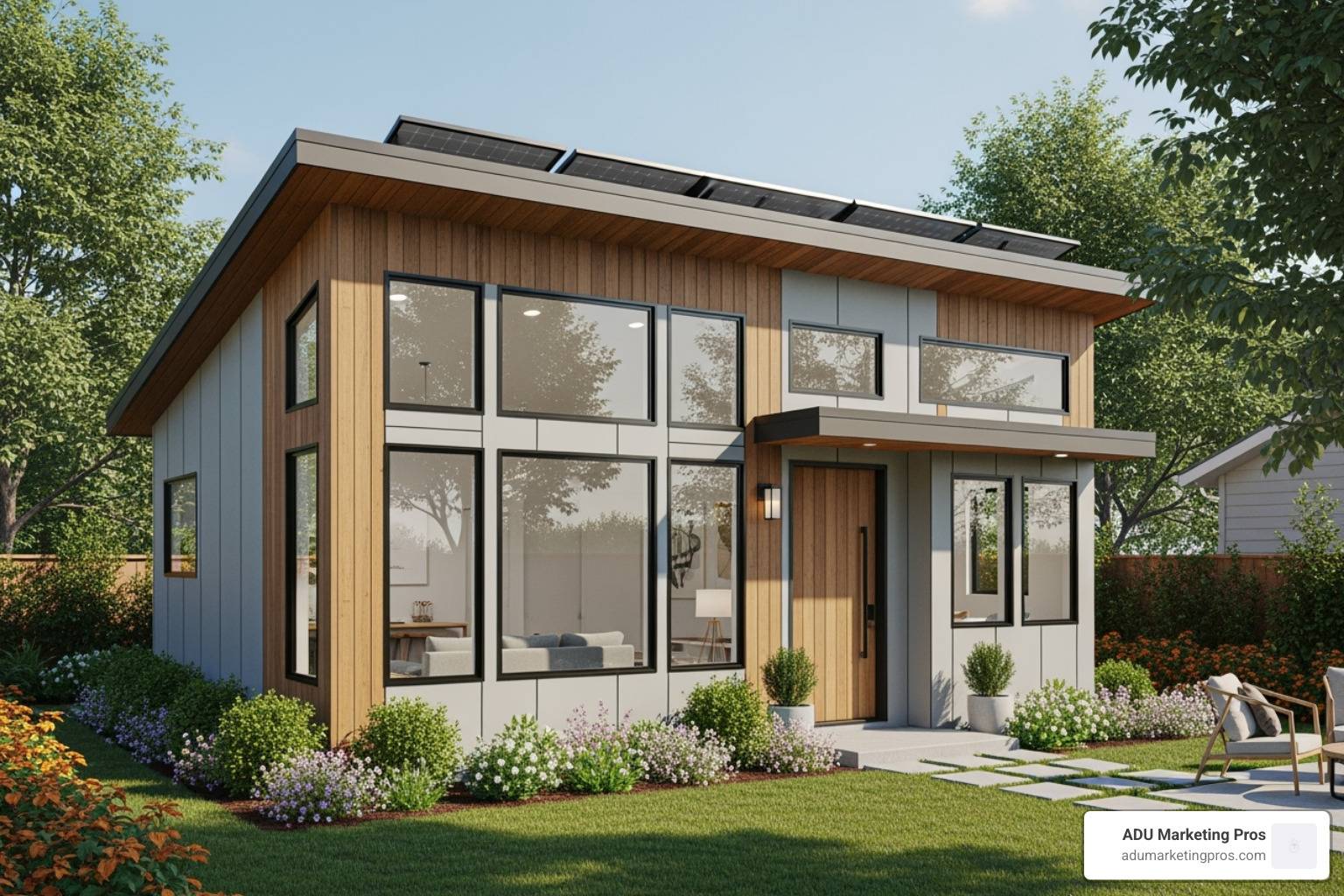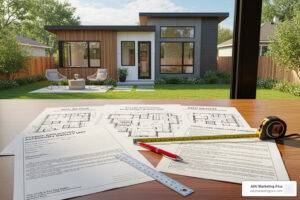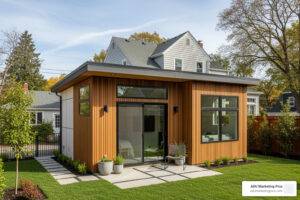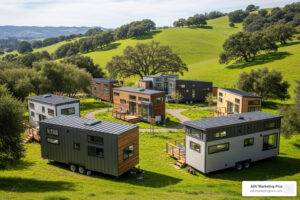Why Energy-Efficient Granny Flats Are a Smart Choice
Investing in energy efficient granny flats offers a wealth of benefits, making them a truly smart choice for modern homeowners. As housing needs evolve, these smaller dwellings are emerging as a premier solution, designed to perform better, cost less to operate, and positively impact both your wallet and the planet. They represent a shift from simply building more space to building smarter space.
Here’s why they stand out:
- Lower Utility Bills: Significantly reduce heating, cooling, and electricity costs month after month.
- Reduced Carbon Footprint: Less energy consumption means fewer greenhouse gas emissions.
- Healthier Living Environment: Enjoy stable temperatures, superior indoor air quality, and more natural light.
- Increased Property Value: Add significant, marketable value to your overall property.
- Year-Round Comfort: Maintain comfortable indoor temperatures regardless of extreme outside weather.
- Future-Proof Investment: Built to higher standards, these homes are more resilient to changing climate conditions and energy price hikes.
Granny flats, also known as Accessory Dwelling Units (ADUs), are gaining popularity for their flexibility. When built with energy efficiency at their core, they become powerful tools for sustainable living. They offer eco-friendly housing solutions that save money, reduce environmental impact, and provide comfortable, independent living spaces for family, renters, or personal use. This guide will explore how these innovative homes achieve such impressive results, from their foundational design to their high-tech features.
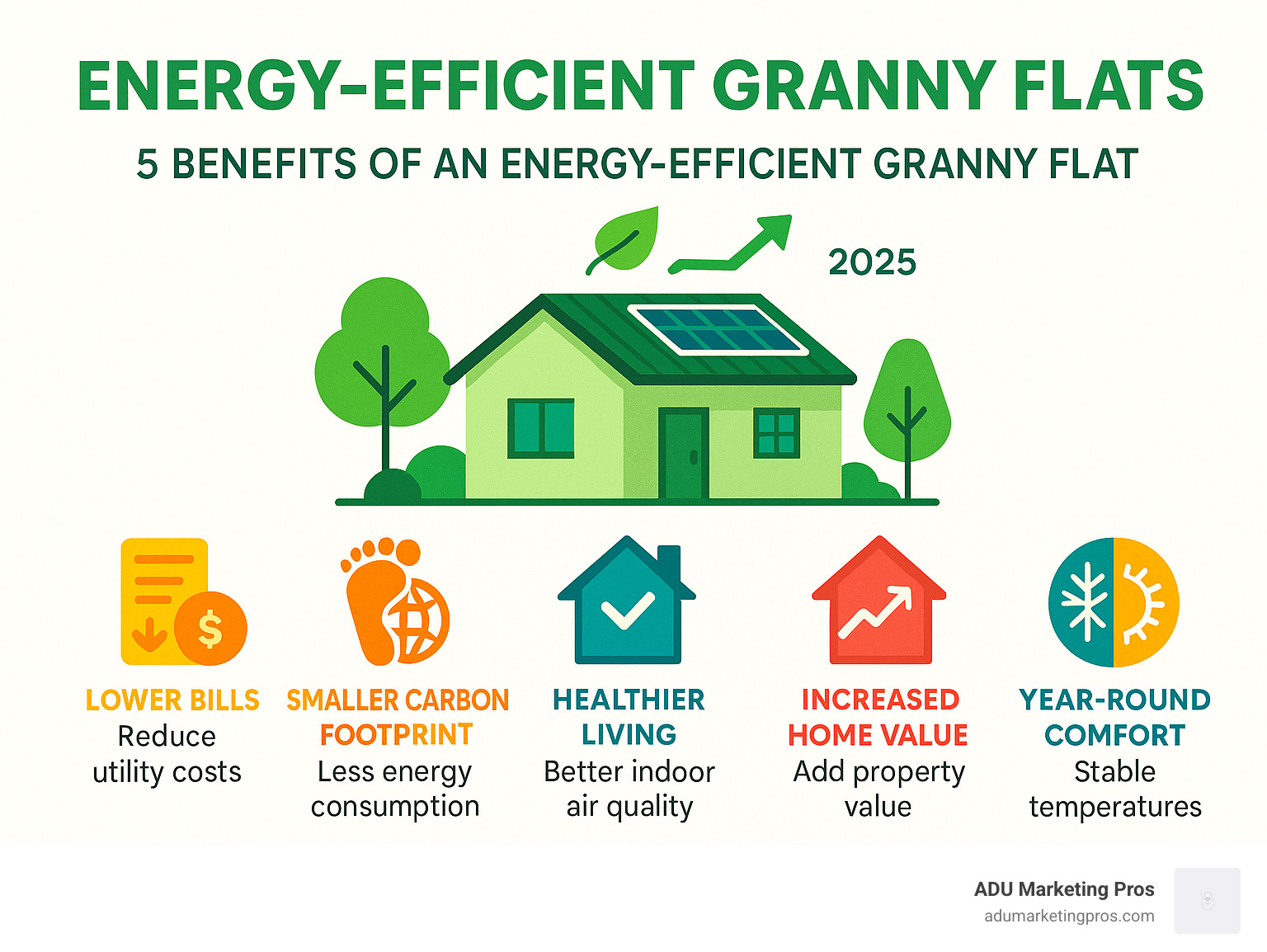
Basic energy efficient granny flats glossary:
The Compelling Benefits: Why Choose an Energy-Efficient Granny Flat?
When you’re considering adding a granny flat to your property, going the energy efficient granny flats route isn’t just about following the latest trends—it’s about making a smart decision that keeps giving back. Think of it as the gift that keeps on giving, benefiting your wallet, your family’s comfort, and the planet all at once.
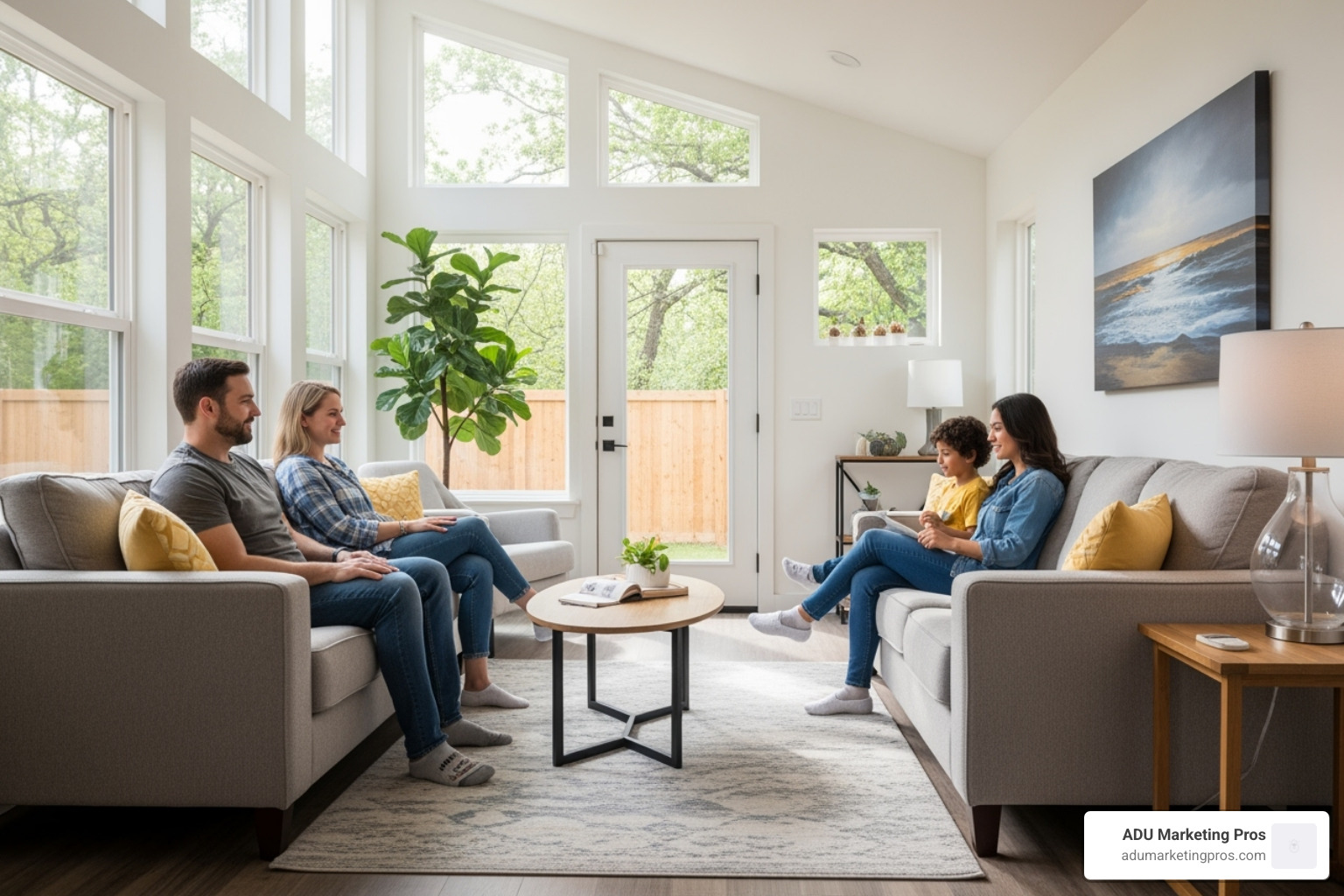
The beauty of energy efficient granny flats lies in their triple benefit: they slash your monthly expenses, create healthier living spaces, and serve as a solid long-term investment. These aren’t just smaller versions of regular homes—they’re thoughtfully designed, high-performance spaces that work smarter, not harder, to deliver superior comfort and value.
Slash Your Utility Bills & Boost Property Value
An energy efficient granny flat dramatically reduces utility bills. Since heating and cooling are the largest energy expenses in most homes, a design that minimizes their use offers significant, immediate savings. Smart choices like superior insulation, high-performance windows, and strategic placement create a naturally comfortable space, reducing the need for a constantly running heater or air conditioner. These monthly savings are not trivial; they can add up to hundreds or even thousands of dollars per year, allowing the initial cost of energy-efficient upgrades to be recouped within a few years.
Beyond the monthly savings, these ADUs significantly boost your property value. Real estate experts report that a well-designed granny flat can increase property value by up to 30%, offering a substantial return on investment. An energy-efficient model is even more attractive to potential buyers who are increasingly savvy about long-term running costs. If you plan to rent it out, an energy efficient granny flat can generate positive cash flow from day one due to its exceptionally low operating costs, making it a more profitable rental unit. For a deeper dive into the numbers, check out our analysis of ADU Return on Investment.
Reduce Your Environmental Impact
Building an energy efficient granny flat is a practical and powerful way to live more sustainably. While a smaller home footprint already uses fewer resources than a larger one, the main environmental benefits stem from intelligent, eco-conscious design. These units can use up to 90% less energy for heating and cooling than conventional homes by employing passive design principles that work with nature rather than against it. Features like solar orientation, natural ventilation, and high-performance materials drastically reduce the carbon footprint associated with the home’s daily operation.
The commitment to sustainability extends beyond energy. Water conservation is another key pillar. Many designs incorporate rainwater harvesting systems, drought-tolerant landscaping, and high-efficiency water-saving fixtures to protect precious water resources and further lower utility bills. The construction process itself can also be greener. By choosing materials with low embodied carbon (the total emissions from sourcing, manufacturing, and transporting materials) and using methods like prefabrication, you can minimize waste and environmental disruption. To explore different sustainable housing options, our comparison of ADU vs. Tiny House offers valuable insights.
Create a Healthier, More Comfortable Living Space
Energy efficient granny flats are inherently designed to be healthier living environments. Their holistic design approach prioritizes excellent air quality, abundant natural light, and stable, comfortable temperatures, all of which contribute to physical and mental well-being.
Superior indoor air quality is achieved through the careful selection of non-toxic materials, such as low-VOC paints and formaldehyde-free cabinetry, and the implementation of controlled ventilation systems. These systems continuously supply fresh, filtered air while exhausting stale, polluted air, which is a significant benefit for anyone, especially those with allergies or respiratory issues. Temperature stability is another major comfort factor. Thanks to excellent insulation and an airtight building envelope, the indoor temperature remains consistent year-round, eliminating uncomfortable drafts in winter and hot spots in summer.
Strategic window placement and design do more than just save energy; they flood the space with natural light, which is proven to reduce the need for artificial lighting and boost mood and productivity. High-performance double- or triple-glazed windows also provide superior acoustic insulation, reducing outside noise and creating a peaceful, tranquil interior. This powerful combination of clean air, stable temperatures, and quiet, natural light results in a home that is not just efficient, but genuinely more pleasant and restorative to live in. For more on creating healthy indoor environments, the Australian government provides excellent resources on indoor air quality.
The Blueprint for Sustainability: Core Principles for Energy Efficient Granny Flats
Designing an energy efficient granny flat requires a holistic approach where every element works in harmony. It’s not about adding a few isolated features, but about creating a foundational plan that integrates smart building science and nature from the very start. This synergy is what ensures optimal performance, durability, and comfort for years to come.
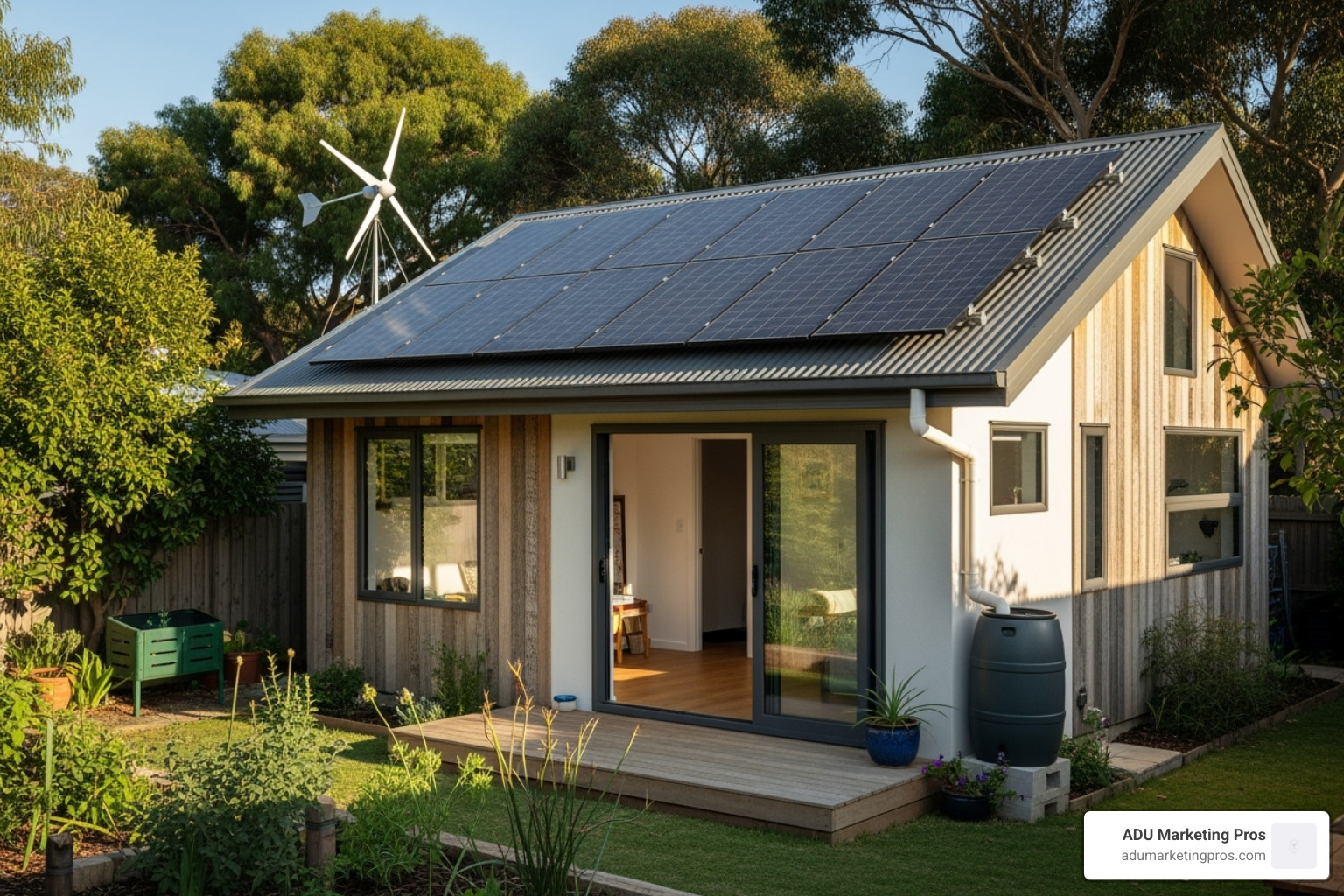
A sustainable blueprint focuses on three core areas: passive design, an efficient building envelope, and strategic site placement with landscaping. When executed correctly, these principles work together to drastically reduce energy consumption while maximizing occupant comfort. For more on current styles, explore these ADU Design Trends.
Passive Home Design: Using Nature’s Power
Passive design is the intelligent core of an energy efficient granny flat, with the goal of reducing heating and cooling energy use by up to 90%. It leverages natural elements like sunlight and air currents to create a comfortable and efficient home. The principles of Passivhaus dwellings are a prime example of this approach in action. Key strategies include:
- Smart Building Orientation: Positioning the granny flat to maximize winter sun exposure (typically with larger windows facing the equator—south in the Northern Hemisphere) for passive heating, while using smaller windows and shading on other sides to block unwanted summer heat.
- Natural Ventilation: Strategically placing operable windows and vents to create cross-breezes that cool the home naturally, significantly reducing or eliminating the need for air conditioning in many climates.
- Strategic Window Placement & Shading: Using high-performance double-glazed or triple-glazed windows with low U-values and appropriate Solar Heat Gain Coefficients (SHGC) to control heat transfer. This is complemented by external shading like eaves, pergolas, or awnings that block high summer sun but allow low winter sun to enter.
- Superb Airtightness: Carefully sealing the building’s exterior shell to prevent uncontrolled air leakage (drafts). This keeps conditioned air inside and unconditioned air outside, which is critical for energy efficiency and comfort.
- No Thermal Bridges: Designing and constructing to eliminate thermal bridges—spots where heat can easily travel through the building structure (like through studs or concrete slabs), bypassing the insulation. This ensures a consistently efficient thermal barrier.
By mastering these principles, a home can maintain a stable, comfortable temperature year-round with minimal mechanical heating or cooling. To learn about the construction phases, see our guide on the ADU Building Process.
The Building Envelope: Superior Insulation and Airtightness
The “building envelope” is the physical barrier between the interior and exterior of your granny flat—the roof, walls, windows, doors, and foundation. In an energy efficient granny flat, this envelope acts as a high-performance thermal shield. Its job is to keep heat in during winter and out during summer. Key components include:
- High-Performance Insulation: This is non-negotiable. Using continuous, high-R-value insulation (like spray foam, rigid foam boards, or dense-packed cellulose) in floors, walls, and ceilings is essential to minimize heat transfer. The higher the R-value, the better the insulation’s thermal resistance.
- Double-Glazed (or Triple-Glazed) Windows: These windows feature two or three panes of glass separated by an inert gas (like argon), which significantly reduces heat loss and gain compared to single-pane windows. Advanced uPVC or thermally broken aluminum window frames also offer superior sound insulation and durability.
- Meticulous Air Sealing: Sealing all gaps, cracks, and penetrations around windows, doors, pipes, and vents prevents air leakage. A professional blower door test can be used to measure the building’s airtightness and identify any leaks that need to be sealed.
- Avoiding Thermal Bridges: Careful design and construction details are used to ensure insulation is continuous. This eliminates points where building components (like wood studs or steel beams) allow heat to bypass the insulation, ensuring uniform thermal performance across the entire envelope.
A well-constructed building envelope creates an airtight and exceptionally well-insulated space, which is the foundation for drastically reducing the need for mechanical heating and cooling. Learn more about what makes an Energy Efficient ADU so effective.
Site Placement and Landscaping for Maximum Efficiency
Strategic site placement and thoughtful landscaping are crucial for maximizing the performance of an energy efficient granny flat. It’s about integrating the building with its natural surroundings to create a symbiotic relationship.
- Sun and Wind: Orient the ADU to take advantage of winter sun for passive heating and cooling summer breezes for natural ventilation. This is the first and most important step.
- Existing Trees: Preserve mature deciduous trees on the sunny side of the home. They provide natural shade in the summer, reducing cooling needs, but lose their leaves in winter to let the warming sun through.
- Drought-Tolerant Plants & Rain Gardens: Use native and drought-tolerant species in landscaping to conserve water and reduce maintenance. Designing rain gardens and bioswales can help manage stormwater runoff naturally.
- Permeable Surfaces: Install permeable pavers or gravel for driveways and paths. These surfaces allow rainwater to soak into the ground, which helps replenish groundwater and reduces the burden on storm drains.
- Proper Drainage: Ensure the site is graded to direct water away from the foundation, preventing moisture issues that can compromise the building’s structure and indoor air quality.
By working with the landscape, not against it, you create a more resilient, comfortable, and efficient home. For more inspiration, check out our ADU Backyard Ideas.
Building Green: Key Features of an Eco-Friendly Granny Flat
Building an energy efficient granny flat means building for the future. It’s a holistic approach that combines smart material choices, renewable energy generation, and modern technology to create a home that is not only efficient and comfortable but also works in harmony with nature.

These key features define a truly eco-friendly granny flat and set a new standard for sustainable living. They are the active systems and smart choices that complement the passive design foundation. For more inspiration, explore these ADU Design Innovations.
Sustainable Building Materials and Finishes
The materials used to construct an energy efficient granny flat have a significant environmental impact long before the lights are ever turned on. We focus on minimizing the “embodied carbon footprint”—the total greenhouse gas emissions from a material’s entire lifecycle, from extraction to disposal. This means selecting materials with a low environmental impact, such as recycled steel framing, reclaimed wood for features and flooring, and rapidly renewable resources like bamboo and cork. Structural Insulated Panels (SIPs) and Insulated Concrete Forms (ICFs) are other great options that combine structure and insulation into one efficient component, reducing construction waste.
For the interior, we prioritize occupant health by using non-toxic and low-VOC (volatile organic compound) paints, sealants, and finishes. These products improve indoor air quality by releasing fewer harmful chemicals into the air you breathe. Sourcing materials locally whenever possible is another key strategy, as it reduces transportation emissions and supports the local economy. To better understand this concept, you can find detailed Information on embodied carbon from authoritative sources.
Renewable Energy and Water-Wise Systems
A truly energy efficient granny flat can become a net-zero energy building by generating its own clean energy and conserving water, making it largely self-sufficient and resilient.
Key energy systems include:
- Solar Panels (Photovoltaics): Rooftop solar panels generate electricity from the sun, which can significantly reduce or even eliminate your utility bills. Pairing them with a battery storage system allows you to store excess energy for use at night or during power outages.
- Solar Thermal Systems: These systems use the sun’s energy specifically to heat water for domestic use, which is often more efficient than using electricity for the same purpose.
- Heat Pumps: These are highly efficient all-in-one systems for heating and cooling. Instead of creating heat, they move it. In winter, they pull heat from the outside air (even when it’s cold) and move it inside. In summer, they reverse the process. Heat pump water heaters work on the same principle and are far more efficient than traditional electric resistance heaters.
Water-wise strategies are equally important:
- Rainwater Harvesting: Tanks collect rainwater from the roof for non-potable uses like garden irrigation or toilet flushing, reducing reliance on municipal water.
- Water-Saving Fixtures: Low-flow faucets, showerheads, and dual-flush toilets are standard, drastically reducing indoor water consumption without sacrificing performance.
- Greywater Recycling: Advanced systems can treat and reuse water from sinks, showers, and laundry for landscape irrigation, saving thousands of gallons of water per year.
These systems are essential to modern eco-friendly design, and efficiency can be incorporated into every part of the home, including in ADU Kitchen Designs.
Smart Home Technology for Ultimate Efficiency
Smart technology acts as the brain of your energy efficient granny flat, automating energy savings and providing you with precise control and valuable insights. These systems optimize performance and convenience, future-proofing your home.
- Smart Thermostats: These devices learn your daily habits and preferences to automatically adjust heating and cooling schedules, saving energy without you having to think about it.
- Automated Lighting & Shades: Systems using sensors and timers with high-efficiency LED bulbs ensure lights are only on when needed. Smart shades can be programmed to open or close based on the time of day or sun’s position to help manage passive heating and cooling.
- Energy Monitoring Systems: These systems provide real-time data on your home’s energy and water consumption, often through a simple smartphone app. This helps you understand your usage patterns and identify opportunities to save even more.
- Smart Appliances: Energy Star-rated smart appliances like dishwashers, washing machines, and dryers can be programmed to run during off-peak hours when electricity rates are lower.
- EV Charging Stations: Integrating an EV charger supports the transition to sustainable transportation and prepares your property for the future of mobility.
Smart technology makes it effortless to minimize your environmental footprint, creating a greener, more convenient, and more intelligent living space, which is also ideal for a modern ADU Home Office.
Frequently Asked Questions about Energy-Efficient Granny Flats
We often hear questions about the practical side of building an energy efficient granny flat. It makes sense! You’re investing your time and money, and you want to know what to expect. So, let’s dive into some of the most common questions to help you feel confident about choosing a more sustainable and cost-effective living solution.
How much more does an energy-efficient granny flat cost to build?
An energy efficient granny flat typically has a higher upfront cost than a standard build, ranging from 5% to 15% more, but this initial investment leads to significant long-term savings. The cost difference depends on the level of performance and the features you choose, such as superior insulation, triple-glazed windows, solar panels, and heat pump systems. While these upgrades add to the initial price, the resulting savings on utility bills often lead to a payback period of 5 to 15 years, after which the investment generates pure savings. Over the 30+ year life of the ADU, the total savings can far exceed the initial extra cost, making it a financially savvy choice with a strong return on investment. It’s also worth exploring green mortgages or energy-efficient mortgages (EEMs), which can help finance these upgrades, as well as local, state, and federal rebates or tax credits for features like solar panels and heat pumps.
Here’s a simplified comparison of potential costs and savings:
| Feature Category | Standard Granny Flat (Estimated Cost) | Energy-Efficient Granny Flat (Estimated Cost) | Annual Energy Savings (Estimated) | Payback Period (Estimated) |
|---|---|---|---|---|
| Insulation | Basic R-value (Included in base) | Higher R-value, superior air sealing (+$2,000) | $150 | ~13 years |
| Windows | Single-pane (Included in base) | Double-glazed, low-E (+$3,000) | $200 | ~15 years |
| Appliances | Standard efficiency (Included in base) | Energy Star rated (+$1,000) | $100 | ~10 years |
| Solar Panels | Not included | 2-3 kW system (+$8,000) | $500 | ~16 years |
| Total Added Upfront Cost | – | ~$14,000 | ~$950 | ~15 years (overall) |
Note: These are estimates. Actual costs and savings vary based on location, climate, product choices, and local utility rates.
For a detailed breakdown, see our guide on ADU Construction Cost.
Can I make my existing granny flat more energy-efficient?
Yes, absolutely. You can make an existing granny flat more energy-efficient through a process called retrofitting. This is a fantastic way to lower utility bills, reduce your environmental impact, and improve the comfort of a current structure.
Start with a professional energy audit. An auditor will use tools like a blower door and infrared camera to identify the most significant sources of energy loss. Based on the audit’s findings, a prioritized list of upgrades can be created. Common retrofits include:
- Improving Insulation: Adding or upgrading insulation in easily accessible areas like attics and crawl spaces is often the most cost-effective first step.
- Air Sealing: Carefully sealing air leaks around windows, doors, electrical outlets, and utility penetrations with caulk and weatherstripping.
- Replacing Windows and Doors: If your budget allows, replacing old single-pane windows with modern double-glazed, low-E models can make a huge difference in both comfort and energy bills.
- Upgrading HVAC and Water Heaters: Swapping out an old furnace or air conditioner for a high-efficiency heat pump, or replacing a standard water heater with a heat pump water heater, can slash energy use.
- Installing Energy Star-rated appliances and switching to LED lighting.
- Adding solar panels to generate your own renewable energy.
Even small changes can add up, so retrofitting can be a cost-effective way to improve the performance of your current ADU. For more ideas, see our ADU Conversion Tips.
Are there specific energy regulations for ADUs in California?
Yes, California has some of the most stringent energy regulations in the country for all new construction, including ADUs. These are outlined in the California Title 24 Building Energy Efficiency Standards, which are updated every few years to push the building industry toward greater sustainability.
For your ADU, Title 24 mandates specific requirements for:
- Insulation levels (R-value) in walls, ceilings, and floors.
- The efficiency of windows (U-factor and SHGC), HVAC systems, and water heaters.
- High-efficacy lighting in all rooms.
- Whole-house ventilation to ensure healthy indoor air quality.
One of the most significant requirements is the solar panel mandate. This requires most new residential buildings, including newly constructed ADUs, to have a solar photovoltaic (PV) system sized to offset the building’s annual electrical usage. This helps homeowners reduce electricity bills and reliance on the grid from day one. Compliance with Title 24 is demonstrated through an energy report, which is a required part of the building permit application. Working with a builder experienced in state and local codes is essential for a smooth and compliant project. For a complete overview, consult our guide on California ADU Regulations.
What kind of maintenance do energy-efficient features require?
This is an excellent question, as proper maintenance ensures your high-performance features continue to operate at peak efficiency. Generally, an energy efficient granny flat does not require significantly more maintenance, but rather different maintenance. Key tasks include:
- HVAC System: High-efficiency systems like heat pumps require regular filter changes (every 1-3 months) and annual professional servicing to keep them running smoothly.
- Ventilation Systems: The filters in your Heat Recovery Ventilator (HRV) or Energy Recovery Ventilator (ERV) need to be cleaned or replaced every few months to ensure good airflow and air quality.
- Solar Panels: Solar panels are very low-maintenance, typically only requiring an occasional cleaning to remove dust or debris that might obstruct sunlight. You should also periodically check that the inverter is functioning correctly.
- Windows and Doors: Periodically inspect the seals and weatherstripping around windows and doors to ensure they remain airtight. Re-caulk or replace seals as needed.
- Water-Saving Fixtures: Occasionally check faucet aerators and showerheads for mineral buildup that could affect flow.
Most of these tasks are simple and can be done by the homeowner, ensuring the long-term performance and savings of your investment.
Conclusion: Your Path to a Sustainable and Savvy Investment
Investing in an energy efficient granny flat is more than just adding space to your property; it’s a forward-thinking financial move and a meaningful step toward a sustainable future. These high-performance homes are carefully designed to be more efficient, more comfortable, and more environmentally friendly than their conventional counterparts.
As we’ve covered, the benefits are clear and substantial:
- Significant financial returns through lower utility bills and an increased property value of up to 30%.
- A dramatically reduced carbon footprint through intelligent passive design, sustainable materials, and renewable energy.
- A healthier, quieter, and more comfortable living environment for you, your family, or your tenants.
From the foundational principles of passive design and a superior building envelope to the active systems like solar panels and smart home technology, every element works in concert to create a truly exceptional eco-friendly home. Energy efficient granny flats represent the future of flexible, resilient, and sustainable housing, whether intended for multi-generational living, rental income, or a private home office or studio.
If you’re ready to begin this rewarding journey, finding the right team of experts is the most crucial step. At ADU Marketing Pros, we connect homeowners with vetted, top-tier ADU construction and architecture firms across California, including Los Angeles, San Diego, and the San Francisco Bay Area. We help these professionals showcase their expertise so you can find a quality builder who specializes in creating beautiful, high-performance homes.
Accept the future of sustainable living. Go green, save green, and make a savvy investment in an energy efficient granny flat. For more on different ADU types, such as modular homes, visit our page on ADU modular homes.

